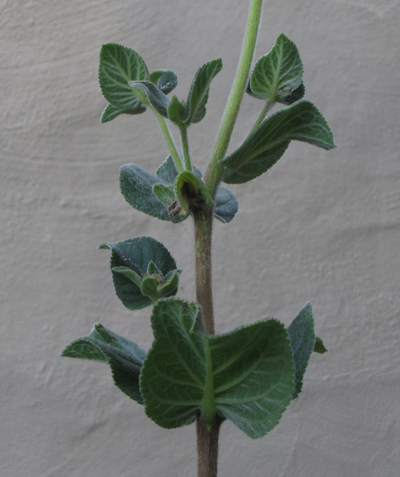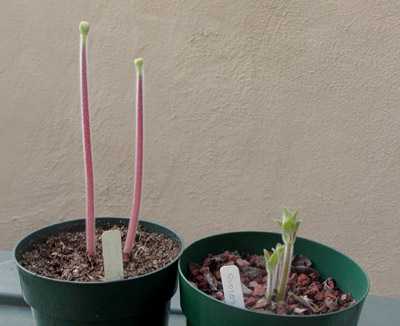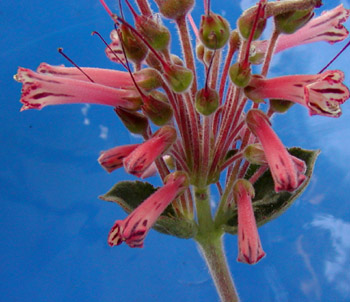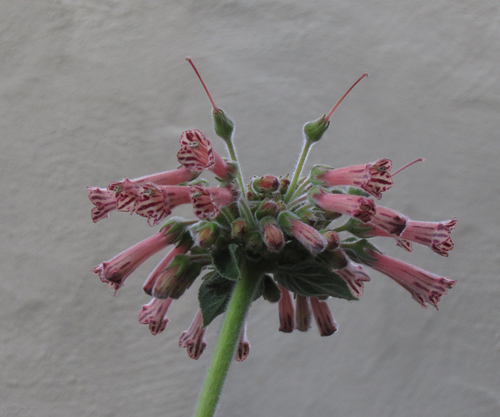|
This species provided another service in my back yard.
I had a couple of plants positioned near a waterbowl for goldfinches to drink from,
and one of the finches perched on a tall stem as a lookout while another sipped from the bowl.
|
This species has hairy tough leaves in pairs or whorls of three.
The flowers are borne in the axils of the upper leaves, which get
progressively smaller up the stem, the topmost being only about 1 cm
long.
The flower is a straight tube, dusty red on the outside, and white
on the inside, with a dark purple streak on each lobe.
The top two lobes overlap, giving the appearance of a single lobe.
During the male phase, the anthers are held right up against these
overlapping lobes.
In all these respects, except for the white tube interior, the flower
closely resembles that of S. douglasii.
The habitats, however, could not be more different:
beach margin for
S. polyantha,
temperate forest epiphyte for S. douglasii.
|

|
With age, the stems become more robust.
In particular, they develop side branches which bear
inflorescences of their own.
This photograph (and the one above) were taken at the
beginning of May 2017, of a plant grown from seed sown
in 2002.
|
Sinningia polyantha was originally published
by De Candolle (a big name in botany) as
Gesneria polyantha in 1839.
It was not in cultivation, but the species was transferred
to Rechsteineria by Kuntze in 1891
and then to Sinningia by Wiehler in 1981.
When the plants discovered along the Atlantic coast were brought into cultivation,
they were given the holding name "sp. Waechter".
The name first suggested was "dunensis", but that was shot down because
"dune" isn't a Latin word or a place name, as the element before -ensis must be.
Next Alain hinted that he would assign it the name "arenicola", a fine species epithet
based on "arena" (Latin for "sand") plus "-cola" ("living in or on").
Unfortunately for that plan, Alain determined that the new material matched the
description of the mostly-forgotten S. polyantha.
"Unfortunately" applies on two counts.
First, "arenicola" was a perfectly appropriate name, expressing the unique character
of this plant.
Second, "polyantha" is not a perfectly appropriate name, since it means "many flowers",
and S. polyantha is not any more floriferous than plenty of other sinningias.
Even so, the tyrannical rules of botanical nomenclature mean we're stuck with it.
Polyantha it is.
|
|
A different plant has been grown under the name S. sp. "Waechter".
When I sowed seed from the AGGS Seed Fund, I two different kinds of plant.
The first, described above, matched what Alain Chautems had applied the name sp. "Waechter" to.
The other had somewhat similar flowers, but otherwise was quite different.
Both varieties came true from seed.
Because of a number of differences described, I gave the second group of plants the name
"Desafinado".
This has now been published as the species
S. ramboi.
A comparison page has a table and some pictures
to demonstrate the differences between the two types.
The picture at the top of the page shows the true "arenicola" with all the flowers
originating from the node -- that is, no peduncle.
The flowerstalk of S. "Desafinado" has a peduncle.
|

|
Light vs. Darkness
This photograph shows what a plant does when there is not enough light.
Both plants are in 5" (13 cm) pots.
The stalk on the left is 9 inches (23 cm) tall.
Both plants are S. polyantha.
The only difference was that the pot on the left spent the winter in a sealed
container with a bunch of other tubers, while the pot on the right was sheltered
from the rain but not in the dark.
One can imagine two strategies for a plant in darkness.
First, make as much photosynthetic (leaf) surface as possible, to capture every
possible photon.
Second, put every bit of reserved energy into extending a stem, in order to get
above whatever has been shading it.
|
Plants have had millions of years to choose between the two strategies, and the
photograph makes it clear which strategy was the winner.
Especially when the plant has a substantial energy store, such as a tuber,
the odds are much in favor of making a long stem rather than large leaves,
but even newly-sprouted seedlings show this behavior.
It should be noted that the strategy was evolved during the millions of
years before sealed plastic tubs existed.
|
Feature table for
Sinningia polyantha
Plant Description
|
| Growth |
Indeterminate |
| Habit |
Upright stem(s). |
| Leaves |
Green, hairy |
| Dormancy |
Stems fully deciduous |
Flowering
|
| Inflorescence |
Flowers borne on a platform inflorescence |
| Season |
Blooms in spring, summer |
| Flower |
Coral, tubular, corolla limbs small, dark streaks on inside of corolla |
Horticultural aspects
|
| From seed |
Two years to bloom, under my conditions |
| Hardiness |
Has survived 30F (-1C) in my yard |
| Recommended? |
Yes, with reservations.
Easy to grow, but the flowers aren't as attractive as those of the related
S. douglasii and S. "Desafinado". |
Hybridization
|
| Hybrids with this species |
See listing. |
Botany
|
| Taxonomic group |
The douglasii group
of the Dircaea clade. |
| Nectaries |
Two, dorsal,
fused into a single unit, with a seam between them only
on the dorsal (adaxial) side |
| Location |
Grows along the coast of Santa Catarina state, Brazil. |
De Candolle 1839 (as Gesneria polyantha).
Wiehler transferred it to Sinningia in 1981.
Chautems confirmed it in Candollea, 2010.
Etymology: From Greek poly- ("many") +
anthos ("flower").
|


